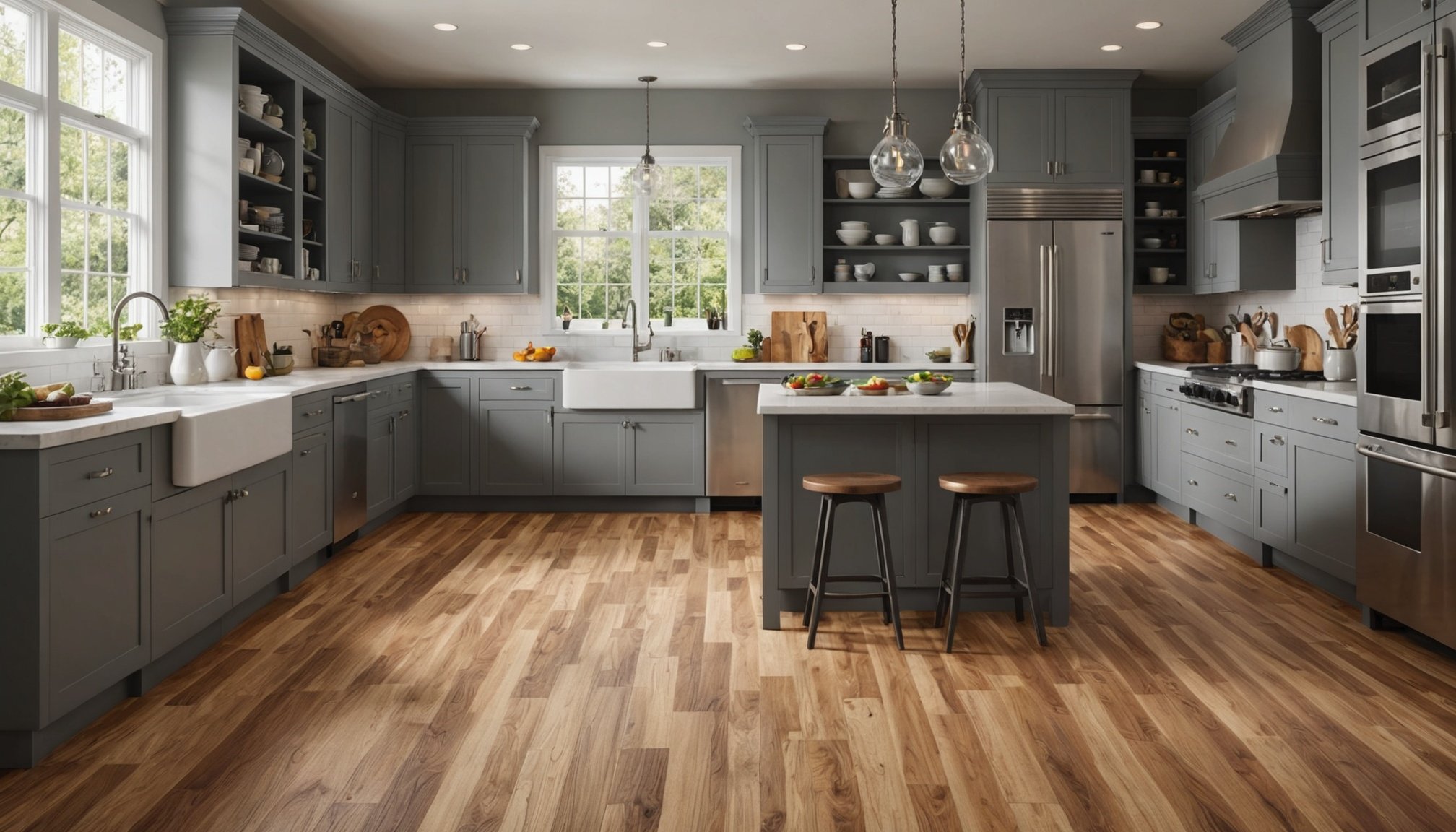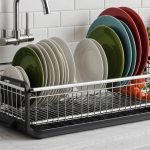Overview of Anti-Fatigue Flooring
Anti-fatigue flooring is a specialised solution designed to enhance comfort and reduce strain for those who spend long hours standing, especially in the kitchen. Its importance cannot be understated given the demands of cooking environments, which often necessitate extended periods of standing, leading to discomfort and fatigue.
Definition and Importance
Anti-fatigue flooring is defined by its ability to absorb shock and reduce foot, leg, and lower back pain, providing a more comfortable cooking and working experience. This flooring style is especially crucial in spaces where individuals stand for prolonged periods, as it helps to redistribute weight and pressure evenly across the surface.
Also to read : Revitalize your kitchen: discover how a built-in composting unit can minimize food waste and foster a sustainable lifestyle
Benefits for Cooking Environments and Health
The benefits of anti-fatigue flooring extend beyond comfort, contributing significantly to the health and well-being of its users. By alleviating physical stress, it can prevent musculoskeletal issues and improve posture over time. Moreover, this flooring can help increase productivity in kitchens by allowing individuals to work longer without the adverse effects of fatigue setting in.
Popular Materials for Small Kitchens
For small kitchens, materials such as rubber and foam are popular due to their lightweight nature and ease of installation. These materials not only provide the needed support and comfort but also conserve space, making them ideal kitchen flooring options for compact areas.
Also read : Illuminate your kitchen: uncover top lighting ideas to create a cozy and motivating culinary haven
Types of Anti-Fatigue Flooring
Choosing the right flooring types for a kitchen can significantly enhance comfort and functionality. Different materials offer distinct advantages, especially in environments demanding prolonged standing.
Rubber Flooring
Rubber flooring is renowned for its durability and water resistance, making it an ideal choice for busy kitchens. It efficiently absorbs shock, providing comfort for extended standing periods, thus reducing fatigue. Additionally, rubber offers varied design options, allowing for aesthetics that match any kitchen decor.
Foam Flooring
Perfect for small spaces, foam flooring is lightweight and provides a soft, cushioned surface underfoot. Its ease of installation and maintenance makes it a popular option among kitchen flooring types. Its softness aids in relieving stress from prolonged standing, proving ideal for compact work areas.
Vinyl Flooring
Vinyl flooring stands out for its versatility in design and colour, offering more aesthetic variety than traditional tiles. It is cost-effective and straightforward to clean, making it practical for a bustling kitchen environment. While providing adequate comfort, it combines the benefits of durability and aesthetic flexibility, making it a valuable alternative to traditional flooring options.
Comparing Anti-Fatigue Flooring to Traditional Options
When considering kitchen renovation, evaluating the benefits of anti-fatigue flooring compared to traditional flooring types is crucial. Traditional flooring choices, such as tiles and hardwoods, have long served kitchens with their aesthetic appeal and durability. However, their comfort levels fall short in environments where prolonged standing is necessary.
Anti-fatigue flooring offers a noticeable difference in comfort. Unlike traditional tiles, which provide hard surfaces, it integrates materials like rubber and foam to cushion and support the feet. This minimizes stress on the body, which is a significant advantage for those spending extended periods in the kitchen.
From a value for money perspective, anti-fatigue floors trickle down advantages in the long term. Besides enhancing comfort, they contribute to reducing medical expenses linked to poor posture and musculoskeletal issues. This contrasts starkly with traditional options, which prioritize aesthetics over ergonomic benefits.
For individuals aiming to balance comfort with aesthetic appeal in kitchen renovation, anti-fatigue flooring presents a compelling alternative. Its integration into kitchen designs not only elevates functionality but also delivers enduring health benefits and supports an overall more enjoyable cooking experience.
Installation Tips for Small Kitchens
When undertaking flooring installation in small kitchens, preparation and careful planning are key. Ensuring a smooth and successful process involves flooring installation, selecting the right materials and considering space constraints.
Preparing the Subfloor
Begin by preparing the subfloor; this step is crucial for any flooring installation. Clean the surface thoroughly, removing any debris or previous adhesive residues. A level subfloor ensures that rubber, foam, or vinyl flooring lays flat, preventing bubbles or uneven surfaces.
Choosing the Right Adhesive and Tools
Selection of adhesives and tools can impact small kitchen renovation work significantly. Use adhesives compatible with the chosen flooring types, ensuring strong bonding and longevity. Basic tools like trowels, utility knives, and rollers are essential for precise and effective installation.
Space Management During Installation
Given the limited space, effective DIY tips include pre-cutting flooring to fit kitchen corners and tight areas. Work in sections, allowing for movement within the confined space without disturbing installed pieces. Moreover, planning the flooring installation in advance optimises usage and reduces waste, ensuring an efficient renovation project.
Maintenance of Anti-Fatigue Flooring
Proper flooring maintenance ensures the longevity and effectiveness of anti-fatigue solutions in any kitchen setup. Each flooring type has unique cleaning requirements that, when followed, can significantly extend its life.
For rubber flooring, regular sweeping or vacuuming can remove loose dirt, followed by mopping with a mild detergent. Avoid harsh chemicals; they can degrade the rubber’s elasticity over time. Foam flooring benefits from straightforward cleaning techniques: use a damp mop with gentle soap to keep it fresh. For vinyl flooring, utilise a non-abrasive cleaner to retain its sheen and avoid scratches – a key in maintaining its aesthetic appeal.
Preventive Measures
Protective measures can help maintain the quality of anti-fatigue flooring. Consider adding door mats to trap dirt and reduce direct sunlight exposure to prevent discolouration. Use protective pads under heavy appliances to alleviate wear.
Addressing Common Issues
Wear and tear is inevitable. Address small tears or scratches early with appropriate repair kits, ensuring they do not escalate. This proactive approach sustains both the visual and structural integrity of the flooring, promoting enduring comfort and health benefits in kitchen settings.
Cost Considerations and Budgeting
Understanding the dynamics of flooring costs is imperative for those considering anti-fatigue solutions in the kitchen. The expenses associated with various flooring types vary significantly, influenced by materials, quality, and installation complexity.
Average Costs of Different Flooring Types
- Rubber flooring typically ranges from moderate to high in price due to its durability and water resistance, with costs averaging £25-£35 per square metre.
- Foam flooring, often chosen for its lightweight nature, is more affordable, averaging £15-£25 per square metre, making it a popular choice in smaller spaces.
- Vinyl flooring stands out for its cost-effectiveness, typically costing £10-£20 per square metre, ideal for budget-conscious renovations.
Budget-Friendly Options
Opting for budget-friendly flooring options does not mean sacrificing quality. Materials like vinyl provide excellent value and diversity without significant expense, offering both comfort and durability.
Factors Influencing Costs
Several factors impact the overall cost, including installation complexity, room size, and subfloor preparation needs. Investing in quality adhesives and contractor expertise may add to initial costs but ensures longevity and effectiveness in the long term. For those eager to balance costs without compromising quality, effective budgeting tips involve assessing long-term benefits alongside immediate expenses.
Visuals and Product Recommendations
When exploring the world of anti-fatigue flooring for your kitchen, product visuals play a crucial role in helping you visualise how these flooring options fit with your space and style. Leading anti-fatigue flooring brands offer detailed images and product reviews that assist in making informed decisions. These visuals showcase various styles and benefits, guiding you to see the comfort and aesthetics these floors bring to a kitchen environment.
Highlighting Top Anti-Fatigue Flooring Products
Some of the top products to consider include durable rubber flooring, easy-to-install foam flooring, and versatile vinyl flooring options. These highlight their practical benefits and stylish designs, addressing both functional and aesthetic requirements. Visuals illustrate the texture and finish, helping homeowners to envision how each option complements their kitchen decor.
Reviews and Testimonials
Reading reviews and testimonials can provide insight into the real-world application and durability of these products. Many consumers praise the comfort benefits and enhanced kitchen experience after installation. Reviews often underscore the reliability of specific brands, helping potential buyers to align their choices with the positive feedback from other users.
Summary of Benefits for Small Kitchens
When considering kitchen flooring options, the advantages of anti-fatigue flooring stand out, particularly in small kitchens where space and comfort blend seamlessly. This type of flooring significantly enhances the cooking experience by providing unparalleled cooking comfort. It absorbs shock effectively, allowing individuals to stand for extended periods without the discomfort typically associated with rigid flooring types like tiles or hardwood.
Beyond mere comfort, anti-fatigue flooring offers substantial health benefits. It supports better posture and reduces the likelihood of developing musculoskeletal issues, which are common concerns for those who spend long hours standing. By doing so, it not only fosters a healthier cooking environment but also contributes to a more enjoyable culinary experience.
When choosing the ideal flooring for your kitchen, it’s crucial to consider your specific personal needs and kitchen dynamics. Reflect on how much time you spend on your feet and the space available. Such thoughtful consideration ensures that your choice of flooring maximizes both functionality and comfort, which is especially beneficial in a small kitchen setting. Embrace the shift towards safer, more supportive flooring to elevate your culinary adventures without compromising on health or comfort.








